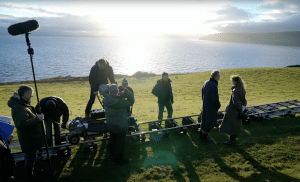Dating back to the 1950s, music videos are perhaps one of the oldest – and certainly one of the most enduring – forms of video marketing. With production budgets ranging from shoestring to several million dollars, creating a good music video that stands the test of time and evermore discerning audiences means that directors and creatives are constantly evolving their ideas. We’ve put together some of the most creative ways stock footage has been used to create some truly memorable music videos, and what each one teaches us about using stock footage in music videos.
1. Cassius: Go Up
Directed by Alex Courtès, this music video demonstrates that taking the time to explore exactly what’s out there in the world of stock footage can yield some pretty incredible results. The premise is simple: Courtès splits the screen in half – horizontally or vertically – and juxtaposes clips with complementary compositions. Real time clips play alongside others shot in slow motion; people and animals come together in bizarre hybrids; footage shot on location is combined with studio clips. What this video demonstrates, above anything, is that the sheer variety of stock videos available can yield some pretty spectacular results. Don’t just look for video content; consider colour, consider composition, and above all, consider what else is on offer.
Director: Alex Courtès
Artist: Cassius (ft. Cat Power and Pharrell Williams)
2. Coldplay: Up&Up
If Alex Courtès put videos next to each other, Vania Heymann and Gal Muggia took the editing process to the next level with Coldplay’s music video Up&Up. The directors of this music video put videos on, under and in other clips. By combining clips – eagles flying underwater, Chris Martin lounging on aerial footage of farm land, cranes in space – Heymann and Muggia have created a fantastical video that speaks to the contemporary issues of our time. The video teaches us to play with scale and orientation; there’s no need to leave stock footage as you found it!
Director: Vania Heymann and Gal Muggia
Artist: Coldplay
3. Darwin Deez: You Can’t Be My Girl
Ah, stock footage. Though the industry is moving away from the saccharine to the authentic, it’s left a legacy in its wake. Couples dressed in blinding white cradle pristine babies and smiling women make uncomfortably-long eye contact as they munch on their salads. These videos are generic for a reason: they’re designed with multi-purpose applications in mind. The upside to this quality, however, is that it’s just asking for that personal touch to be added into what can sometimes be an impersonal collection of footage. Keith Schofield took this brief literally, it seems. The music video inserts Darwin Deez himself into stock videos, transforming innocuous clips into a weird and whacky narrative. The creative takeaway? Don’t be afraid to inject a little – or a lot – of yourself into your music video.
Director: Keith Schofield
Artist: Darwin Deez
4. Kanye West: Bound2
The music video has been around a long time and, like stock footage, it’s picked up a few stereotypes of its own along the way: sunsets, galloping horses, scantily dressed women on motorcycles. The musician in front of a green screen is to music videos what women laughing and eating salad is to stock. Where Keith Schofield embraced stock footage’s awkward teenage years, Nick Knight has done the same for the music video. Stock clips establish the film’s grandiose mood and feel, and fade into the background to reveal the man himself. The lesson here is simple: sometimes you’ve got to go all in.
Director: Nick Knight
Artist: Kanye West
5. Ratatat: Drugs
Who doesn’t love a good montage? Especially when it’s as bizarre as this one. Carl Burgess has taken yet another well-loved music video formula – the talking head montage – and turned it, well, on its head. Stock models are cut from their clips, and put against a generic background, family portrait style. There is a lot of creative inspiration to be taken from this video, but we’ll hit you with a practical one: the model release is an underrated advantage of stock footage. Did the actors in this video think that their footage would be set to electronic rock and disseminated on YouTube as a souped-up “this is your brain on drugs” short film? Probably not. Did they sign a form allowing footage of them laughing, crying and/or flexing to be used in this way? Absolutely. When it comes to stock video, it’s not just the cinematic legwork that has been done for you; a lot of the paperwork has as well.
Director: Carl Burgess
Artist: Ratatat
6. Sevdaliza: Amandine Insensible
Sometimes the medium is the message. Unlike Darwin Deez, inserted into stock clips, or Up&Up’s allusive approach to contemporary issues, Sevdaliza and Piet Langevelt, like Kanye, went all-in. The music video for Amandine Insensible comprises stock footage, yes, but stock footage for which Sevdaliza herself was the model. She becomes the everywoman of the song – every fantasy and no reality in one. Footage used in the video – Sevdaliza “performing your preferred daily routine,” as she puts it – is available to purchase from Shutterstock. The takeaway here is to embrace the multipurpose nature of stock video: how many times have snippets of an artist’s other song or music video made it into the video for another song? On how many different platforms does one video proliferate? We’ll take the underlying criticism of the stock footage industry because Sevdaliza has tapped into something important: your preferred clip is out there. And it can be begged, borrowed, stolen (though we don’t endorse this), and even recycled or repurposed.
Director: Piet Langevelt
Artist: Sevdaliza
7. Tame Impala: Nangs
Ok, “a stock footage nightmare” is kind of rude. But there is also some weird stuff out there, and Ben Aston has made sure we know it. Sevdaliza finishes her music video watermarked and copyrighted, but in the video for Nangs by Tame Impala, the watermark is there from start to finish. And why not? This is, after all, how a lot of people encounter stock footage in the wild and the two are commonly associated. We presume (and hope) that Ben Aston did, in fact, take the time to license these clips properly, but the inclusion of the watermark nonetheless raises an important point. The watermark serves as a unifying thread throughout the video and reminds us that you can do more than just combine separate pieces of footage into a single shot like in the Darwin Deez, Cassius, or Coldplay videos. Stock overlays and motion graphics are equally useful creative building blocks and can be a great weapon in your arsenal for amping up the mood or message of your video.
Director: Ben Aston
Artist: Tame Impala
Bonus Round!
It’s pretty clear that a lot of time, effort, and consideration went into finding the right stock footage for these music videos. It’s also clear that this was time well-spent and has often influenced the creative process by turning up some pretty spectacular clips. Did you know you can buy footage of a man lying naked in a room full of servers? Neither did we until Ben Aston went out and found it. So, in recognition of the hours these filmmakers spent scouring the internet, we’ve included a video that demonstrates that maybe, just maybe, they didn’t have to.
8. Muse: Dig Down
We’ve already given a little shoutout to Brightly’s found-footage, twitter-trawling lyric website-cum-video in our article about using video in your web design. Now Muse have come out with something similar. They’ve tasked an AI tool with scraping whatever editorial footage is available online for words and phrases that, pieced together, sing the lyrics to Dig Down, the song in the video. The program ran for a month, during which time the video was in a constant state of change. So our final little takeaway is that there is more than one way to edit a video. Why not see where coding and the world of stock and archival footage can take you?
Software Developer: Branger_Biz
Artist: Muse
And there we have it! 7 creative ways stock footage has been used to make some unusual and engaging music videos, and the creative inspiration you can take from each one! This list covers a lot of bases, from the practical to the artistic, and even (in the case of our super-special bonus number 8) how to find footage without trawling the web yourself. What do you think? Let us know!




